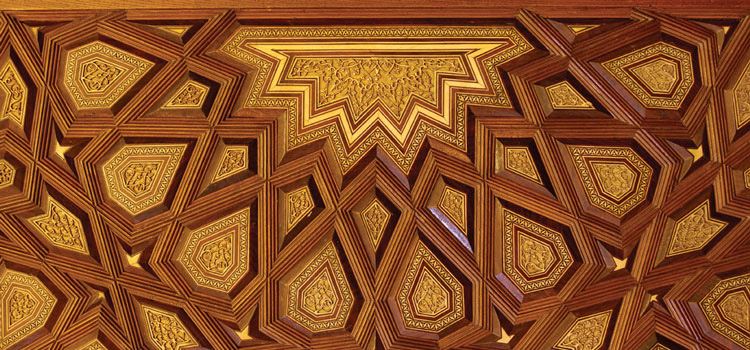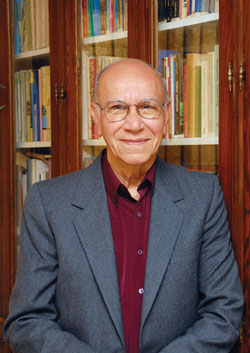s
CONTACT US |

FEATURES Meet the Arab Press ALUMNI PROFILES AKHER KALAM
|
| Making a Mark By Peter Wieben Photos by Ahmad El-Nemr
Fahmi was an unlikely person to be pondering with Thoron that afternoon. He had spent years as a typesetter and illustrator working at the U.S. Embassy. To produce a single page of printed material could take hours at that time, and Fahmi was something of an artist hermit, spending long hours meticulously preparing documents for printing. Since an early age, he had spent much of his time alone –– drawing, painting or writing. His peaceful life was disrupted, however, with the onset of the Six-Day War in 1967. The embassy staff had been evacuated, leaving all Egyptian staff to fend for themselves. As former employees of the United States, they were pariahs. “We were not accepted by the Egyptians because we had worked with the Americans, and we were not accepted by the Americans because we were Egyptian,” Fahmi recalled. Out of work and without a penny in his pocket, Fahmi took up a job in a printshop making 10 piasters a day. “I did anything they asked, mostly sweeping and cleaning.” Luckily, his fortunes were about to improve. In a strange twist of fate, the war would result in the founding of one of AUC’s most prestigious institutions –– the AUC Press. At the same time, Fahmi would be taken from his odd jobs and given a new career as a university printer and typesetter. “It happened that the American embassy donated all of the printing presses to AUC. We were part of the machines,” he said. Fahmi and an Italian co-worker followed the machines to a small room in AUC. “We created our own work. At first, that was just forms and letterheads,” he noted. Soon, however, Fahmi’s work drew the attention of AUC President Christopher Thoron, whom Fahmi described as an artist, a man who was suffering from cancer, but who spent his time at AUC making an impact that lasts to this day. “He knew he was dying,” said Fahmi. “He made a great effort to polish the image of AUC. At that time we had no logo, no official type, no colors.” As time went on, Thoron and Fahmi worked with increasing focus and dedication to finish what both men saw as a crucial task for the university. They found themselves sitting in Thoron’s office considering attributes for a new logo. “We were thinking of a logo that gave thoughts of motion,” he explained. “It also had to express that this was a scientific place –– scientific but not stale.” Fahmi said that he and Thoron considered using an atom as the logo, but Fahmi was uncomfortable with this idea. “It wasn’t enough for a university,” he explained. “Everyone was using it. Second, it didn’t have an Arab image. It needed to smell of Egypt.”
Thoron’s stroke of inspiration became arduous work for Fahmi, and for the next three months he drew, measured and cut shapes based on the president’s door. Finally, after many lonely hours in a drawing room, he settled on the pentagon that characterizes AUC today, each of its five sides a copy of Thoron’s sketch. When the logo was sent to the United States to be reproduced, it fell to Fahmi to suggest colors that he felt would represent the university. At the time, he said, universities around the region favored the hard primary colors they felt symbolized strength. Fahmi, who had worked as AUC’s hidden artist for years, selected black and red, which he described as different and more sensitive.
“A few years later, the square vanished,” said Fahmi. With his logo now being used around the New Cairo Campus, Egypt and the world, Fahmi maintains a low profile. He spends much of his time in his study lined with thousands of books, all of which Fahmi has read. After leaving AUC, he continued to find comfort in his solitude, but became a quietly prolific artist, writing more than 30 books and producing thousands of poems, paintings and songs. Fahmi says his life was never about achieving fame or fortune. Since the months he spent assembling AUC’s iconic logo, he hasn’t given the symbol much thought, even though his design has traveled the world and been seen by millions of people. “I draw things, I write things, and when I am finished, I put them behind me,” he said. “There is no use holding on to what you create. In the end, it doesn’t really belong to you.”
|
 Former AUC President Christopher Thoron and illustrator Naim Fahmi were sitting in the president’s office and staring at the walls. It was the early 1970s and the two men were engrossed in a project that had occupied them for weeks, the outcome of which they hardly could have predicted at the time. Their goal was to design a new logo that would represent the university and unify its image. At the time, AUC’s disparate departments often marked their publications with designs unrelated to the university or each other.
Former AUC President Christopher Thoron and illustrator Naim Fahmi were sitting in the president’s office and staring at the walls. It was the early 1970s and the two men were engrossed in a project that had occupied them for weeks, the outcome of which they hardly could have predicted at the time. Their goal was to design a new logo that would represent the university and unify its image. At the time, AUC’s disparate departments often marked their publications with designs unrelated to the university or each other.  As they considered the problem, Thoron happened to glance up at the door of the president’s office in the Main Campus palace. “He looked at the wooden doors and traced a small unit of the artistic paneling,” Fahmi recalled. “He gave me the paper and told me to play with the shape.”
As they considered the problem, Thoron happened to glance up at the door of the president’s office in the Main Campus palace. “He looked at the wooden doors and traced a small unit of the artistic paneling,” Fahmi recalled. “He gave me the paper and told me to play with the shape.” His logo has been successful. Fahmi recalls that near the end of his time at AUC, high-profile designers were hired to redesign the logo. The result was a thin square around the logo, and a change of colors to ochre and burgundy.
His logo has been successful. Fahmi recalls that near the end of his time at AUC, high-profile designers were hired to redesign the logo. The result was a thin square around the logo, and a change of colors to ochre and burgundy.